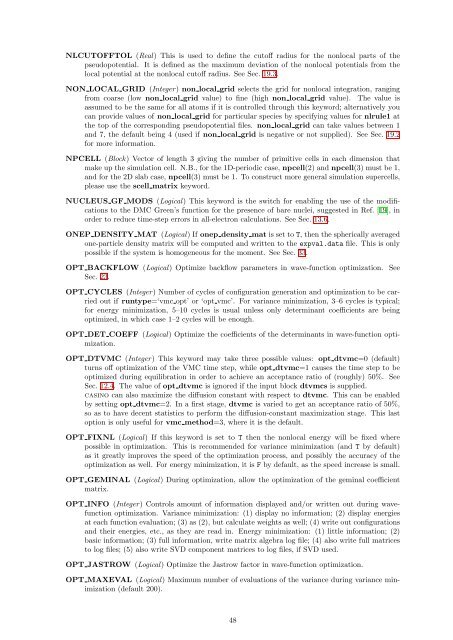CASINO manual - Theory of Condensed Matter
CASINO manual - Theory of Condensed Matter
CASINO manual - Theory of Condensed Matter
Create successful ePaper yourself
Turn your PDF publications into a flip-book with our unique Google optimized e-Paper software.
NLCUTOFFTOL (Real) This is used to define the cut<strong>of</strong>f radius for the nonlocal parts <strong>of</strong> the<br />
pseudopotential. It is defined as the maximum deviation <strong>of</strong> the nonlocal potentials from the<br />
local potential at the nonlocal cut<strong>of</strong>f radius. See Sec. 19.3.<br />
NON LOCAL GRID (Integer) non local grid selects the grid for nonlocal integration, ranging<br />
from coarse (low non local grid value) to fine (high non local grid value). The value is<br />
assumed to be the same for all atoms if it is controlled through this keyword; alternatively you<br />
can provide values <strong>of</strong> non local grid for particular species by specifying values for nlrule1 at<br />
the top <strong>of</strong> the corresponding pseudopotential files. non local grid can take values between 1<br />
and 7, the default being 4 (used if non local grid is negative or not supplied). See Sec. 19.2<br />
for more information.<br />
NPCELL (Block) Vector <strong>of</strong> length 3 giving the number <strong>of</strong> primitive cells in each dimension that<br />
make up the simulation cell. N.B., for the 1D-periodic case, npcell(2) and npcell(3) must be 1,<br />
and for the 2D slab case, npcell(3) must be 1. To construct more general simulation supercells,<br />
please use the scell matrix keyword.<br />
NUCLEUS GF MODS (Logical) This keyword is the switch for enabling the use <strong>of</strong> the modifications<br />
to the DMC Green’s function for the presence <strong>of</strong> bare nuclei, suggested in Ref. [19], in<br />
order to reduce time-step errors in all-electron calculations. See Sec. 13.6.<br />
ONEP DENSITY MAT (Logical) If onep density mat is set to T, then the spherically averaged<br />
one-particle density matrix will be computed and written to the expval.data file. This is only<br />
possible if the system is homogeneous for the moment. See Sec. 33.<br />
OPT BACKFLOW (Logical) Optimize backflow parameters in wave-function optimization.<br />
Sec. 23.<br />
See<br />
OPT CYCLES (Integer) Number <strong>of</strong> cycles <strong>of</strong> configuration generation and optimization to be carried<br />
out if runtype=‘vmc opt’ or ‘opt vmc’. For variance minimization, 3–6 cycles is typical;<br />
for energy minimization, 5–10 cycles is usual unless only determinant coefficients are being<br />
optimized, in which case 1–2 cycles will be enough.<br />
OPT DET COEFF (Logical) Optimize the coefficients <strong>of</strong> the determinants in wave-function optimization.<br />
OPT DTVMC (Integer) This keyword may take three possible values: opt dtvmc=0 (default)<br />
turns <strong>of</strong>f optimization <strong>of</strong> the VMC time step, while opt dtvmc=1 causes the time step to be<br />
optimized during equilibration in order to achieve an acceptance ratio <strong>of</strong> (roughly) 50%. See<br />
Sec. 12.4. The value <strong>of</strong> opt dtvmc is ignored if the input block dtvmcs is supplied.<br />
casino can also maximize the diffusion constant with respect to dtvmc. This can be enabled<br />
by setting opt dtvmc=2. In a first stage, dtvmc is varied to get an acceptance ratio <strong>of</strong> 50%,<br />
so as to have decent statistics to perform the diffusion-constant maximization stage. This last<br />
option is only useful for vmc method=3, where it is the default.<br />
OPT FIXNL (Logical) If this keyword is set to T then the nonlocal energy will be fixed where<br />
possible in optimization. This is recommended for variance minimization (and T by default)<br />
as it greatly improves the speed <strong>of</strong> the optimization process, and possibly the accuracy <strong>of</strong> the<br />
optimization as well. For energy minimization, it is F by default, as the speed increase is small.<br />
OPT GEMINAL (Logical) During optimization, allow the optimization <strong>of</strong> the geminal coefficient<br />
matrix.<br />
OPT INFO (Integer) Controls amount <strong>of</strong> information displayed and/or written out during wavefunction<br />
optimization. Variance minimization: (1) display no information; (2) display energies<br />
at each function evaluation; (3) as (2), but calculate weights as well; (4) write out configurations<br />
and their energies, etc., as they are read in. Energy minimization: (1) little information; (2)<br />
basic information; (3) full information, write matrix algebra log file; (4) also write full matrices<br />
to log files; (5) also write SVD component matrices to log files, if SVD used.<br />
OPT JASTROW (Logical) Optimize the Jastrow factor in wave-function optimization.<br />
OPT MAXEVAL (Logical) Maximum number <strong>of</strong> evaluations <strong>of</strong> the variance during variance minimization<br />
(default 200).<br />
48

















